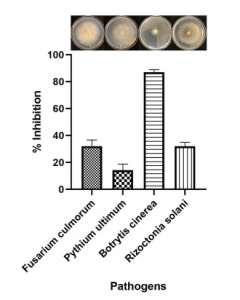A group from Department of Molecular Genetics, University of Groningen, Groningen, Netherlands, etc. has reported that Bacillus cabrialesii BH5 Protects Tomato Plants Against Botrytis cinerea.
https://www.ncbi.nlm.nih.gov/pmc/articles/PMC8441496/
To date, more and more reports show that applying plant growth-promoting rhizobacteria (PGPR) into agriculture as biological control agents is a successful strategy for plant disease control. PGPR can influence plant growth by either facilitating resource acquisition or modulating plant hormone levels. Moreover, PGPR can decrease the various pathogenic effects, either by evoking immunity of plants or by producing antimicrobial compounds.
It was shown that Bacillus cabrialesii BH5 isolated from the rhizosphere soil of a healthy tomato plant shows potent biocontrol activity against fungal pathogens via producing an antifungal compound named fengycin H (see below).
 (The antifungal activity of volatile organic compounds (fengycin H) produced by BH5, strong inhibition against botrytis cinerea)
(The antifungal activity of volatile organic compounds (fengycin H) produced by BH5, strong inhibition against botrytis cinerea)
It was also found that B. cabrialesii BH5 is able to promote tomato plant resistance to B. cinerea by activating the jasmonic acid (JA) signaling pathway, which is own mechanism to deal with pathogens and to coordinate the appropriate defense responses. Actually, the expression of the JA signaling pathway-related gene SlLoxD in fengycin H or BH5 treatment was always significantly higher than that in control from 48 to 96 h.
The effect of BH5 on the growth of tomato seedlings was monitored by measuring the shoot/root length, shoot/root fresh weight, and dry weight. B. cabrialesii BH5 showed a significantly increase of fresh and dry weight both of the shoot and root.
